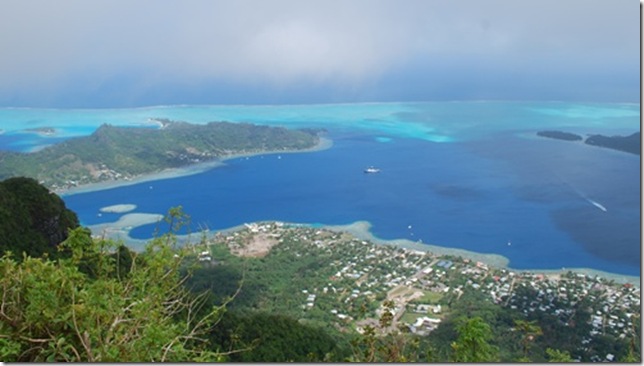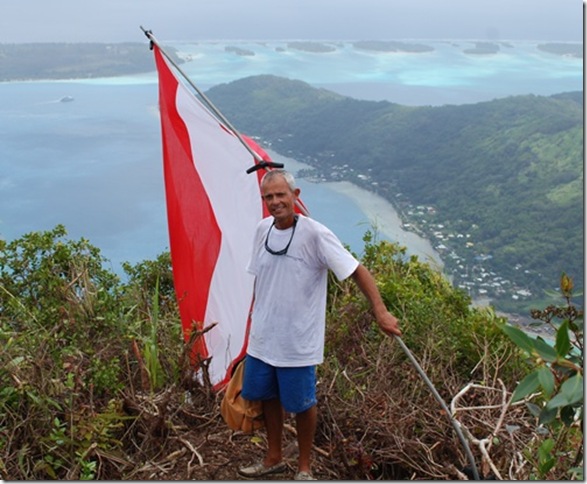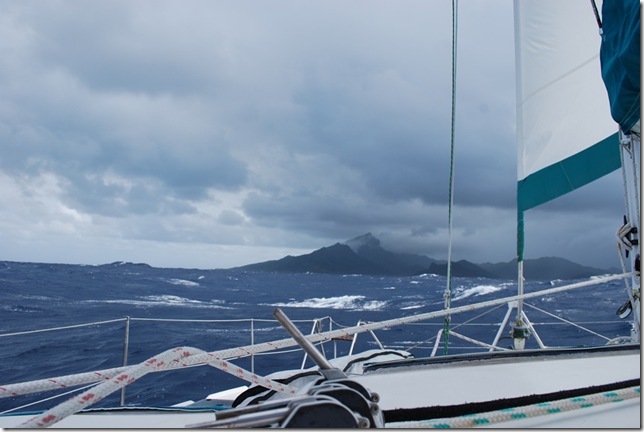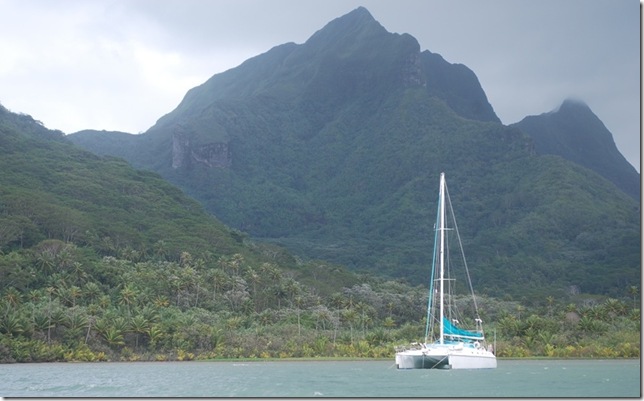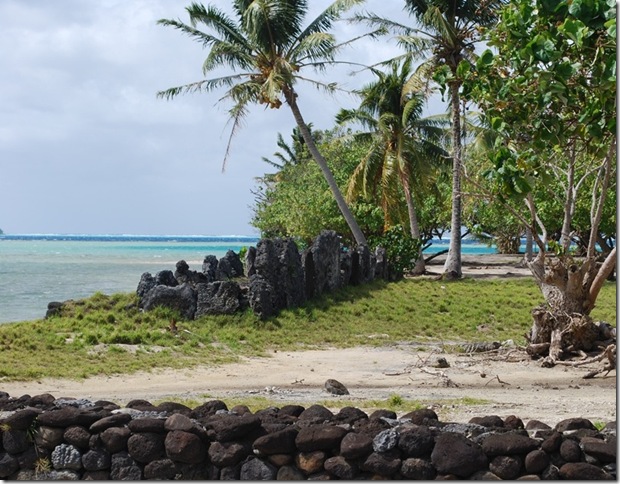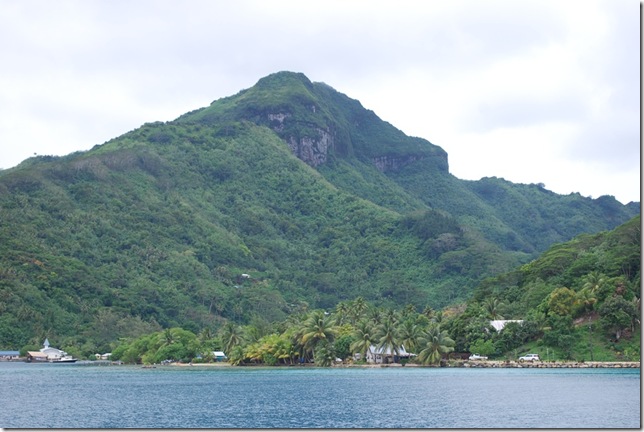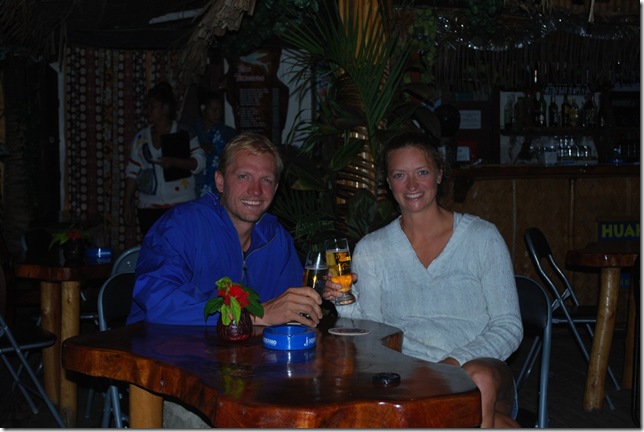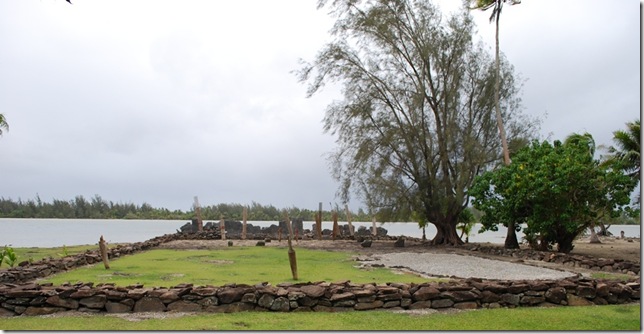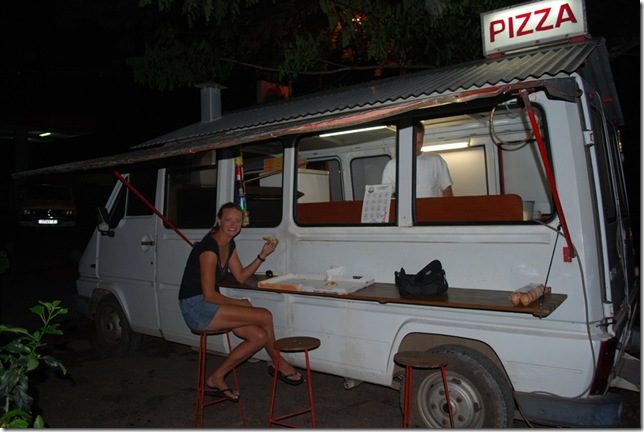We awoke on Friday morning at Marina Apooti and had our usual eggs and potato breakfast (two ingredients that are readily available here), which we shared with Robby, the Hawaiian delivery skipper who we’d met while walking the docks the night before. He’s on his 79th Pacific crossing, most of the time running between Hawaii and California. When he is not making deliveries, he serves as the bowman on racing crews–the person who handles the lines and sails on the foredeck. He claims to be well known in Hawaiian racing circuits and once changed headsails 10 times in 6 minutes according to the changing winds. He also claims to have sailed with famed mariners such as Robin Lee Graham and B.J. Caldwell and to have caught halibut in Alaska that weighed several hundred pounds. We can’t verify the accuracy of any of these stories, but they were entertaining nonetheless.
After saying good-bye to Robby, we took SHOWERS, the first real showers (i.e., with indoor plumbing) we’d had since we stayed at a hotel in the Galapagos. There wasn’t any hot water, but it was surprisingly enjoyable. I had forgotten how good it feels to have sufficient water pressure to rinsed away all the soap (and maybe even use some conditioner!). That probably sounds pretty funny to all of you landlubbers, but I would bet that most cruisers can relate to it.
Throwing off the bow and stern lines at Marina Apooti was much easier than getting them on, and off we motored into the calm lagoon. We were expecting to have some rough seas like we had had en route to Raiatea once we got out of the protection of its lagoon, but although they were “confused” (coming from various directions), they were only 2-3 feet, not too bad by our standards. After we had sailed a fair distance away from the isles of Raiatea and Ta’haa, the seas began to organize into impressive rollers that still weren’t that big, but I was glad we were sailing with rather than against them.
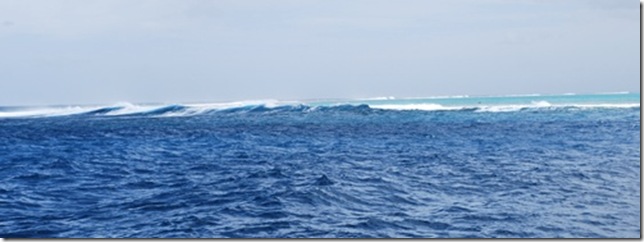 Waves breaking onto the reef encircling Ta’haa
Waves breaking onto the reef encircling Ta’haa
Bora Bora is well known for its clear and colorful lagoon and is listed in more than one cruising guide as having the most beautiful anchorages in the world. We were not disappointed as we approached and could see the rugged peaks of the island enveloped in bright turquoise water. Along the edge of the lagoon we could see the thatched-roof bungalows of the expensive hotels that are frequented by celebs and honeymooners. There were also several dive boats and glass-bottom boats buzzing about, confirming what we had heard about the abundant marine life here.
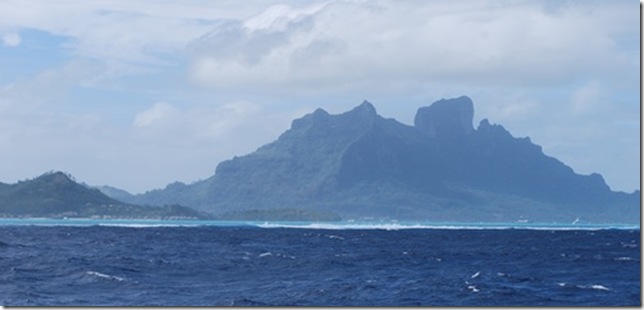 Our first glimpse of the lagoon of Bora Bora
Our first glimpse of the lagoon of Bora Bora
Our friends Dave and Shauna aboard Dragon, the boat for which Dallas and Wes served as linehandlers on their first trip through the Panama Canal, had informed us by email that they were staying on a mooring buoy at the Yacht Club of Bora Bora. However, we could tell from afar that that bay was packed with boats, so we thought we’d try to anchor in the adjacent bay. In the midst of checking it out, Dave and Shauna came over by dinghy to greet us and informed us that while there were no buoys available at the Yacht Club, five boats were leaving the following day. They also reported that for $50/week for the buoy, we would also get to use the shower and laundry facilities and take part in the yachties’ social hours, barbeques, etc. Although we tend to enjoy less populated anchorages, this sounded like a fun change of pace for a few days, so we settled in for the night at a nearby anchorage (from which Wes and Tiff were able to dinghy into the village) and got up early to watch for boats leaving. The first two boats left at 7:00 a.m. We motored over soon thereafter and helped ourselves to one of the mooring buoys for which some people have had to wait 4-5 days.
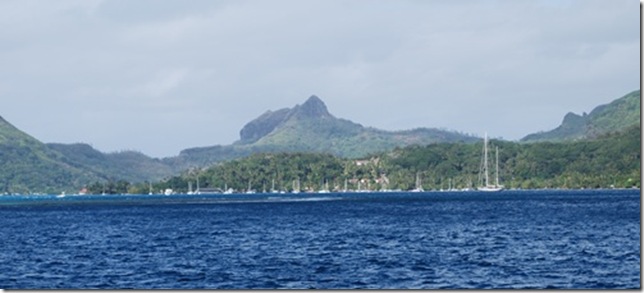 Boats moored at Yacht Club of Bora Bora
Boats moored at Yacht Club of Bora Bora
Dave and Shauna popped over in their dinghy on their way into town for a shopping run. We started the process of catching up on events of the last couple of months (since Panama), but the raging winds made it difficult to hear. I asked Shauna if they would like to join us for lunch (as Dallas, Tiff, and I had discussed over breakfast), and she agreed. Meanwhile, Dave asked Dallas if we would like to join them for dinner aboard Dragon, and naturally, Dallas agreed. So we got a double-dose of the vibrant South Africans yesterday. Dave and Shauna are very social people and seem to have met all of the cruisers who have come through the Yacht Club in the last few weeks. It was interesting to hear their second-hand stories of the cruisers’ various experiences, both personal and sailing-related. One of the most noteworthy in my mind was the American who sailed from California to the Marquesas living primarily on Snickers bars and Coke. Dave and Shauna discovered this when, after noticing the sails sitting untended to on the deck of his boat with no one in sight for 3 days, they got concerned and went over to check it out. In response to their calls, he emerged looking very gaunt and very appreciative of the leftovers that Shauna brought over!
This morning Dallas and I set off with Dave of Dragon to climb the volcanic peaks of Bora Bora, with the highest point at 2,385 feet. Dallas set a pretty quick pace, and it was not long before I was panting from the exertion and the altitude. Fortunately my lungs seemed to adapt as we pressed on, and it was not long before we arrived at the really steep sections toward the top that required you to use ropes to pull yourself up. It was about this time that we met some American cruisers who were on their way down who explained to us why it was not possible for them to make it to the top. We sympathized, but as Dave noted, this also posed a challenge for us. Suffice it to say that 2.5 hours after we set off, we arrived at the summit of the mountain to see an absolutely breathtaking view of the surrounding lagoon with its many, many shades of blue. What’s more, the atmosphere seemed to have put us all in a pensive mood, as we had an uncommonly good conversation with Dave, an articulate and insightful former labor attorney, about relationships, money, happiness, and all that good stuff over lunch.
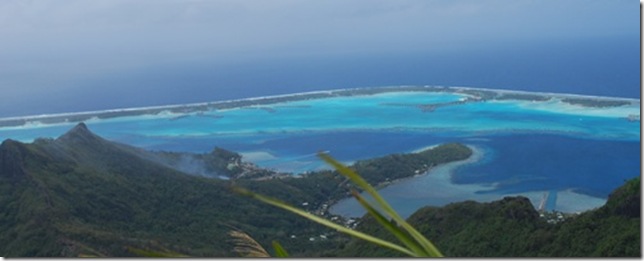 View from the top of the mountain
View from the top of the mountain
Dave was an ideal hiking companion
The hike down the mountain was almost as challenging as the way up. It was muddy and slippery in many places, and at the pace we were going, I had to concentrate on where to put my hands and feet next to avoid sliding. Sometimes slip-sliding was unavoidable, in which case there was only one thing to do–drop down onto my bum. By the end of the hike, we were beyond dirty, but I am pleased to report that the Yacht Club’s lone shower (unisex once again) is “divine”, to borrow one of Shauna’s trademark words. That’s right, we’ve had two real showers in three days! We’d better not get to used to it, though, as we don’t expect to see another until New Zealand.
Though exhausted, we are pretty jazzed about the mountain climbing. Dallas even said that he would like to do it again tomorrow! Fortunately for my aching body, we have other things on the agenda such as visiting the gendarme and the bank to get our bond back from the French Polynesian government. With any luck, that will go smoothly and we can bike or dive in the afternoon. There’s quite a bit to do here in paradise.
Getting our anchor up in Huahine did turn out to be a bit of work, but for the wrong reason. On her dive yesterday, Lauren had worked to clear the chain from the coral, so bringing the chain in was easy until the boat was over the deeper water, where the windlass couldn’t bring it up and it appeared to be stuck.
I decided to dive on it and we made a plan. Lauren worked the bow and Tiff worked the helm. 5 minutes after I started down, they would let out 10 feet of chain, then 30 seconds later they would start the normal process of trying to bring the anchor up. I would be working down below to help clear things if they were fouled. My left ear is still bothering me, and I needed most of the 5 minutes to get down over the wall and to the bottom of the channel at 68 feet, where the anchor was just laying on the sandy bottom, barely dug in. Right on time, they started the attempt to pull the anchor up, but it wasn’t working even though I could see we weren’t stuck on anything. After a minute or two, I came up, made a decompression stop, and got back on board. It turned out the windlass clutch had loosened up and all we needed to do was tighten it. After tightening it with a wrench, the rest of the chain and windlass came right up (90 feet of 5/16″ chain, a 25 kg anchor, and a 30 lb mushroom anchor / kellet were a bit too much with the clutch loose) and we were off.
I had been pretty sure that I saw whales outside the pass on our way in, and just after we cleared the pass, I saw a the blow and back of a humpback straight ahead. We got to see the whale breach and raise its tail before diving several times. They’re big, of course, and their movements are in slow motion compared to the dolphins that we’re used to seeing. There was a blow, followed by the slow movement of the large back and small fin through the water before the tail broke out and raised almost straight up then disappeared below the waves. When we first spotted them directly ahead, they were close enough that I slowed the boat down to avoid a potential collision and to keep from disturbing them. The second time we saw them, we had passed over them and they were behind, between the boat and the pass. 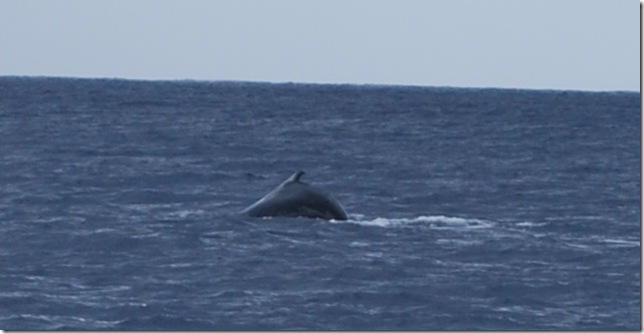
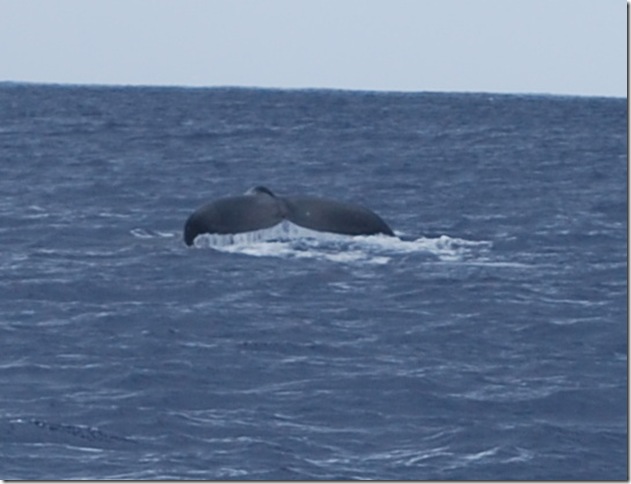
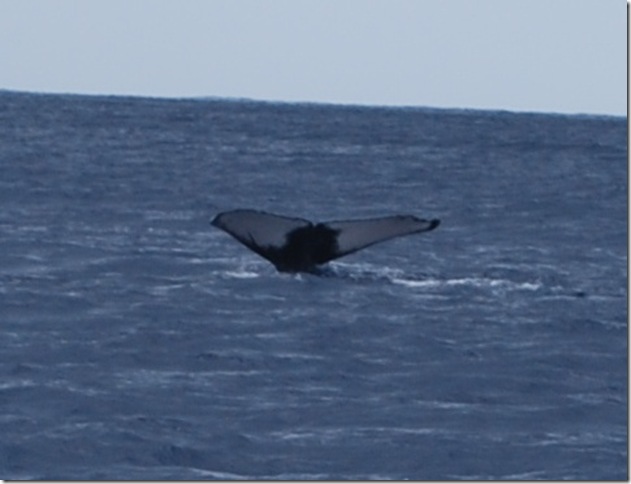
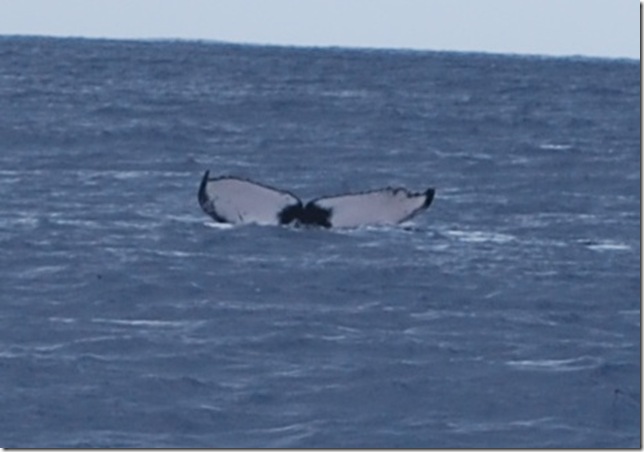
We’d chosen a lively day for the crossing but we were ready to move on, hurricane season is getting closer, and there was the potential need to look for an engine mechanic or part. The local weather predicted 20-25 knots and 3+ meter seas. They were pretty much right on. In the sustained gusts, we got up to a steady 7.3 knots on just the jib. For me, it is mesmerizing to watching 10-12 foot heaps of water rise up beside you then pass underneath you. I’m always amazed how well the boat rides up and over the seas when we aren’t trying to pound directly into them. It was a lively ride, but far from the worst we’ve had, and it made the passage go by quickly.
Te (The) Ava (Pass) Moa (Sacred) pass is narrow and deep, and although the cruising guide said it was practicable in strong winds, we had a backup plan for the next pass north in case the entrance was covered with breakers. Right in the middle of furling the jib, about a mile from the pass, a bee landed on my left palm and left his barb in my hand. That smarted a bit. The pass didn’t come into view until we were fairly close, but it was very calm and we motored into the lagoon with no problems at all. The pass ends at a point of land that separates two bays. The bay to the north is the site of Marae Taputapuatea, the largest and most important marae site in all of Polynesia. Before Europeans selected Tahiti as a capital for the region, the Raiatea was the most important island in the region due to its religious traditions and influence. Archeologists and historians generally believe that Raiatea was the legendary island and center of culture from which most of the rest of Polynesia (including Hawaii, Easter Island, and New Zealand) was discovered and colonized. The marae there served as an international marae, with people coming in canoes from far away to participate in ceremonies. It also served as a launching place for canoe voyages of discovery and colonization.
The bay to the left of the pass was reported to be sheltered and have excellent holding in a mud bottom, so we headed there to ride out another windy night at anchor. The mud did indeed provide excellent holding, and we got some much needed rest before Lauren and I headed out to see the marae the next morning. The site contained several maraes, all impressive in terms of their size and setting at the edge of the lagoon with a view of the ocean and Huahine. This marae and the ones in Huahine are a bit different than the ones in the Marquesas both in terms of their style of construction and because they use slabs of coral stone instead of the large volcanic boulders.
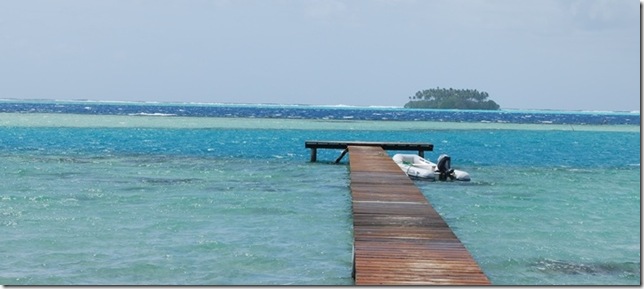 Our dinghy and the beautiful colors of the lagoon
Our dinghy and the beautiful colors of the lagoon
The port engine is still giving a low oil pressure alarm at low RPMs when it’s warm, so we decided to head to the north tip of Raiatea, where there is a concentration of charter companies and yachting business in the hopes that we can find another oil pressure regulator, and oil gauge to do some troubleshooting, or possibly a mechanic.
Along the way, we enjoyed one of the true pleasures of sailing the South Pacific — sailing through the lagoon in fresh tradewinds. Although the ocean outside the lagoon was worked up even worse than it was yesterday, inside the lagoon there was only a light chop. We were able to sail with the wind and chop northwards, up the east coast of Raiatea, with the beautiful mountains off to port and the pretty lagoon with the ocean breaking on the reef at its edge off to starboard. With only the jib up, we made just as good of time as if we were running both engines, but enjoyed a quiet, scenic sail instead.
We spent the night at Apooti Marina, home of the Moorings, Sunsail, and Tahiti charter businesses. The guidebook indicated that we could get technical assistance here, but they were only able to provide us with a phone number for a business in Papeete that could possibly put our part on a plane to Raiatea or Bora Bora. Oh well, they have showers, which is worth the $25 if they’re hot (we’ve heard they’re not, but we’ll see). We can see Bora Bora from here and are planning to head that way later today.
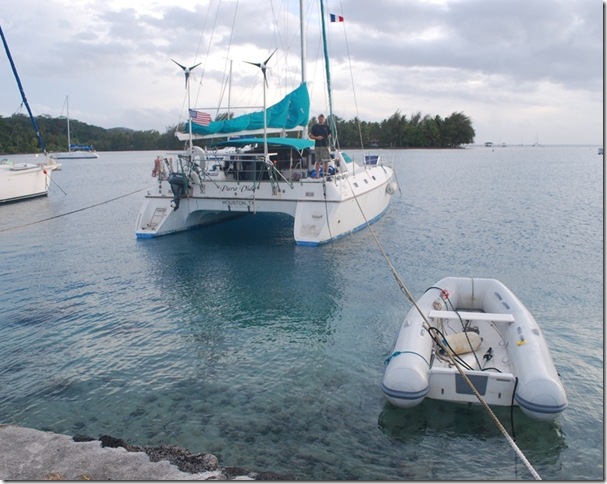 Tahitian mooring with the dinghy rigged to be pulled back and forth
Tahitian mooring with the dinghy rigged to be pulled back and forth
We did anchor watches all night in the storm, but our anchor held just fine. Silvio’s advice was to drop the anchor at the drop-off at the edge of the sand bank / lagoon channel, so that the anchor would pull uphill. That worked well, but with all of the coral head and coral on the wall of the channel, getting the anchor up is going to be a challenge. Matajusi tried moving yesterday and I ended up helping them by diving down with scuba gear to free the anchor, which was wrapped around coral. Lauren tried taking a look at our anchor yesterday when she jumped in for a while to relax. The chain was snaking around coral heads and then disappeared over the wall at the edge of sand bank. She followed it down to 30 feet before coming back up. It should be interesting to retrieve today.
If the wind doesn’t get too bad, we’re headed for Raiatea in an hour or so, about 20 miles away. We’ll probably make a short stop of a day or two at the south end of the island and then move on to Bora Bora (another 30 miles), our last official stop in French Polynesia. We should make it there before Dragon, the boat we crewed on through the Panama Canal, has left for Tonga, and it will be nice to catch up with them. We’ve been trading e-mails ever since Panama. Yesterday, we could see Bora Bora on the horizon just north of Raiatea and Tahaa.
 Raiatea (left) and Tahaa (right). Bora Bora is farther right, but hard to see in the pic.
Raiatea (left) and Tahaa (right). Bora Bora is farther right, but hard to see in the pic.
We were planning to move yesterday, but didn’t make it. We got around a little too late to get to Raiatea, and ended up doing some file swapping with Matajusi in the afternoon. They’re getting a bunch of our movies, and we’re getting cruising guides for a good portion of the world.
We finished the day with some time in town. There’s a restaurant/bar by the beach, so I treated Lauren to a few of the draft Hinanos she’s been craving. We also couldn’t resist another pizza from the pizza van. From the tables nearest the beach, you can see the outline of the woman of Huahine in the mountain contours (it’s much easier to “see” at night). She has a bit of a pot or pregnant belly, and the legs take a little imagination, but the face and chest are easily identifiable. It’s been a while since we were sitting in a touristy waterfront restaurant/bar. As cool as it is to watch the sunset, etc. from the boat, it was nice to get off it for a while and enjoy the view with a cold draft and hot pizza.
The woman’s belly, a pretty peak near the anchorage
Today started with a bad harbinger. It was another rainy, windy day, and when we got up I noticed our usually very trustworthy anchor had drug about 80 feet and we were too close to a channel marker. After eating, we moved the boat up and re-anchored closer to the boats in front of us. Just after finishing, we noticed that Matajusi, who were were now fairly close to us had started to pull up their anchor as well. I was initially afraid that they thought we had anchored too close, so when they finished, I dinghied over to explain that we’d drug and say sorry if we’d moved too close. It turns out that they had drug as well after their anchor had snagged and then broken a large piece of coral, so they were moving up as well.
Silvio and I were both headed into the water to check our anchors, so we met beside the boat. He’s a good free diver, and I had thrown on the scuba gear from yesterday, as I still had some air in the tank. When I took a look at the anchor, it seemed to be dug in well, but the cruising guide says the area doesn’t have good holding and I noticed that there were a lot of 3″-6″ pieces of rock, coral, and shell in the sand that seemed to make it difficult for the anchor to really dig. I added a 30 lb. mushroom anchor about 4 ft. from the main anchor to help hold the chain down so that it was pulling on the anchor from the optimum direction, let out another 10 ft. of chain, and headed back down below.
We were checking our position every hour to make sure we weren’t dragging, but about 40 minutes after 5pm, I felt a really strong gust and thought about getting up to check the anchor. Wes and Tiff had braved the rain to go into town, I was in our berth checking e-mail, and Lauren was in the salon Skyping with her sister. A few minutes after the gust, I heard Lauren yell that we were dragging, and I ran up on deck. A loud whistle from our friend Silvio on Matajusi had alerted her, and when we made it out on deck, we were precariously close to the partially awash coral heads. There was coral behind us, heads awash only 50 ft. or so to port, and plenty of heads in the shallow water in front and to starboard of us that our anchor may be fouled on. We were only in 8 ft. of water (our draft is 3.5 ft), and coral heads dotted the bottom all around us.
We turned the engines on, and Lauren took the helm while I ran to the bow to try to get the anchor on board. With the strong wind pushing us onto the heads, shallow water all around, and almost no room to maneuver, it looked like pulling up the anchor and chain was going to be challenging and dangerous. The wind was loud, but it was blowing from the bow to the stern, so Lauren was easily able to hear me when I yelled instructions for quick turns with plenty of throttle to try to get over the top of the anchor. Luckily, after a couple of maneuvers I could see the anchor was loose and hollered back to Lauren to increase the throttle again and head out of the shallow water.
Matajusi had pulled their anchor up as well in the meantime and were headed out of the anchorage. Lauren and I took turns at the helm so we could change from the wet shorts we had run on deck in to dry clothes and foul weather gear. Wes and Tiff were still ashore, so we tried radioing and making a pass near the main dock, but then decided we were going to have our hands full getting the boat safely anchored before nightfall, so we motored off toward the south. There’s a pretty exposed sand bank inside the lagoon that the cruising guide recommends for this type of weather, but I was hoping to find something more sheltered, so we tried the nearby bay just to the south. Unfortunately, it’s a deep bay that doubles as a wind tunnel, and the rain felt like small stones (think sticking your head out of the car window when you’re doing 60 mph in the rain). We made it halfway down the bay and then turned back for the sand bank.
It was dark, but Matajusi had already anchored there and gave us some good tips on where to try anchoring. We finally got the anchor dropped in about 20 ft of water, put out 150′ of chain, and added some heavy-duty chafe-guard for the bridle.
While we waited to make sure things were going to hold, we made contact with Wes and Tiff over the radio and thanked Silvio for his well-timed whistle. They had started to drag at the same time, and had noticed that we were moving quickly toward the reef. Not knowing if we were monitoring channel 16 (we always do), Silvio used his ability to whistle loudly to get our attention. We learned from Spica, the German boat we’ve seen a couple times since Panama and visited last night, that a French boat in the anchorage had also had problems. Spica had been able to chase down their dinghy, which had broken loose, but they weren’t answering on 16 and no one knew whether they had moved or had headed offshore to ride things out.
Once it seemed like things were holding, Wes and Tiff headed back to the boat, and we’re taking turns doing anchor watches tonight, as the wind is gusting over 45 kts and seems to just be getting stronger.
There’s a saying that says sailing is 99% boredom and 1% sheer terror. We were never at any personal risk, so we didn’t break too far into the 1%, but the boat was one loud whistle and about 50 feet from having a really bad day, and that definitely got the blood pumping.
Believe it or not, we’ve been here since Friday, and Lauren and I just took our first trip ashore yesterday. We’ve enjoyed a couple days of snorkeling, diving, and catching up on e-mail. It’s been overcast and rainy most of the time we’ve been here, but you’re going to get wet diving anyway, and even overcast days don’t hide the beauty of the island.
Huahine came well recommended from a number of people and they didn’t steer us wrong. It’s a high island, like the Marquesas, but the mountains have softer, less rugged contours and include some beautiful tree varieties that aren’t found in the Marquesas. In addition to the surrounding lagoons, the Society Islands in general enjoy a coastal plain region that circles the island at its base. Nearly all of the population lives in this strip of fairly flat land, along a main road that rings the island. It’s a change in population density from the inhabited but isolated valleys of the Marquesas and makes it very convenient to explore the island by bicycle (if anyone knows how to repair a slightly bent rim before it gets worse, let us know). The freedom of movement allowed by the coastal plain areas probably also played a role in these islands having a more united government and religious organization than the Marquesas.
Huahine has been inhabited since about 850 AD. The ancient name for the island means "joyous breeze", but at some point it was changed to the current Huahine, which refers rather explicitly to a member of the female anatomy ("Hine" means woman and translations of "Hua" apparently include hole and sex). There’s a legend that says the name of the island comes from a princess who escaped nearby Raiatea by floating away inside a large drum. She and the warrior who found her named the 10 regions of the island after their children. It’s been interesting to hear the island legends that explain names and origins of the various places, but it does seem a little unlikely that the Tuamotus were formed by a strong storm that knocked off some pieces of the Marquesas. The name is also said to come from the outlines of the mountain peaks, which supposedly look like a woman lying down when viewed from the beach here at Fare. The other story we heard is that the name is derived from a round bay on the east side of the island with a large, natural basalt column towering above it. At any rate, even though the island is reputed to be endowed with femininity and was ruled by a Queen when Cook arrived, Lauren’s certain is was actually named by a man. Apparently the people of Huahine weren’t too keen on becoming French. There were a number of battles and Huahine wasn’t annexed until 40 years after Tahiti, with the population not getting French citizenship until 1945.
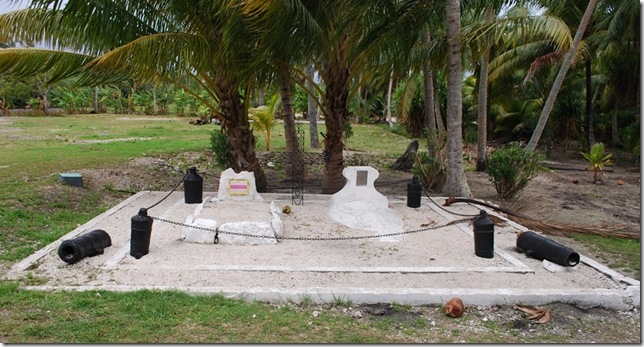 Memorial to those killed in the battles between the French and the natives
Memorial to those killed in the battles between the French and the natives
In addition to being a beautiful emerald ring around the island, the lagoon provides a lot of recreation and resources. The locals are frequently out canoeing and fishing and the diving is great. The swell from the south creates some incredibly picturesque surf waves, but with a jagged reef marking their final destination, I think I’ll wait for a sandy beach to make another effort at learning to surf. When Lauren and I finally made it ashore, we re-traced the path Wes and Tiff had taken. On the north side of the island there’s a large lagoon with a small river-like entrance that is actually referred to as a lake. Fish parks are common here and in the Tuamotus as a method of raising fish to sell in Tahiti, but here there is also an ancient method of building stone walls in the channel that feeds into the northern lagoon to route and capture ocean fish. The stone walls don’t appear to be in use anymore, but there were definitely active fish farms in the area.
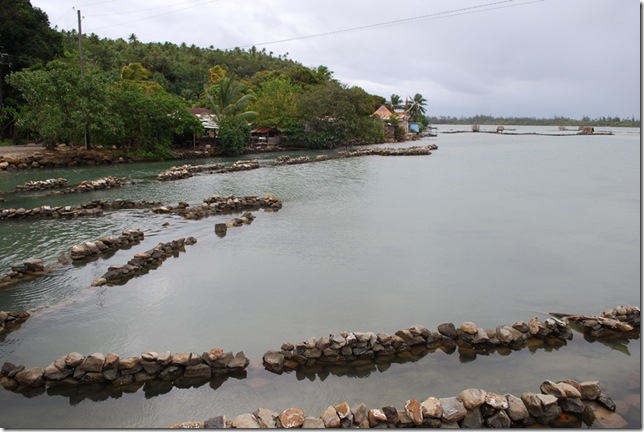 Stone walls in the foreground and a fish farm in the background
Stone walls in the foreground and a fish farm in the background
Along the way, there was an area where there are a number of marae by the lagoon, which are a bit different here than in the Marquesas. Here they are large, open areas paved with stone and featuring a single raised area. There aren’t any tikis or carvings, and much of the structure and ornamentation was made of organic materials, so there’s not much left to see besides the foundations, though the size and lagoon-side setting are memorable.
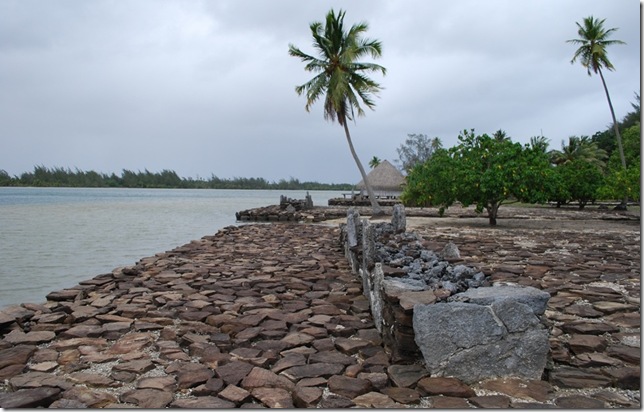 Three adjacent marae at the edge of the lagoon
Three adjacent marae at the edge of the lagoon
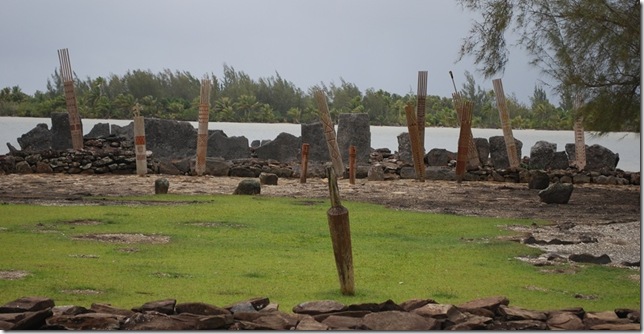 Wooden carvings decorating the large marae
Wooden carvings decorating the large marae
Not much was open when we made it back to town Sunday night, but we did find something that sparked our interest: a pizza van! This time the thin-crust pizza was incredibly good. Tbe ingredients were all western-style and the pizza was cooked in a small pizza oven inside the truck. After diving and biking, we were hungry enough that we almost ordered another one. I’ve been joking about opening up a "Gringo Burrito" stand to make a few bucks in New Zealand since Lauren and I have been making homemade tortillas and burritos, but the pizza option is now under consideration as well.
Just when you think the list of boat repairs is shortening, you realize the futility of thinking those kind of thoughts. The port engine had done well after tightening the oil pressure regulator until just as we finished anchoring when it started squeaking, just at the edge of the threshold for going off. Luckily, nearby Raiatea is the charter and yachting capital of French Polynesia and if it’s still a problem, we should be able to find a mechanic there. Our sail cover was questionable when we left Florida, and it’s developed numerous tears, but it’s still protecting the main from UV damage and should get us to New Zealand. While the winds are about 25 knots offshore, here they howl down from the mountains and the gusts feel like they’re easily topping 40 knots, but the cover hasn’t blown off yet. Yesterday, we turned the inverter on and the control panel started beeping and displaying an error code. I opened the cockpit locker where the inverter is located and saw smoke coming out of it. I’ll try a bit of troubleshooting at some point, but it’s a well know fact that once the magic smoke has escaped, electronics typically lose their functionality. Luckily we have some small inverters that we should be able to get by with.


